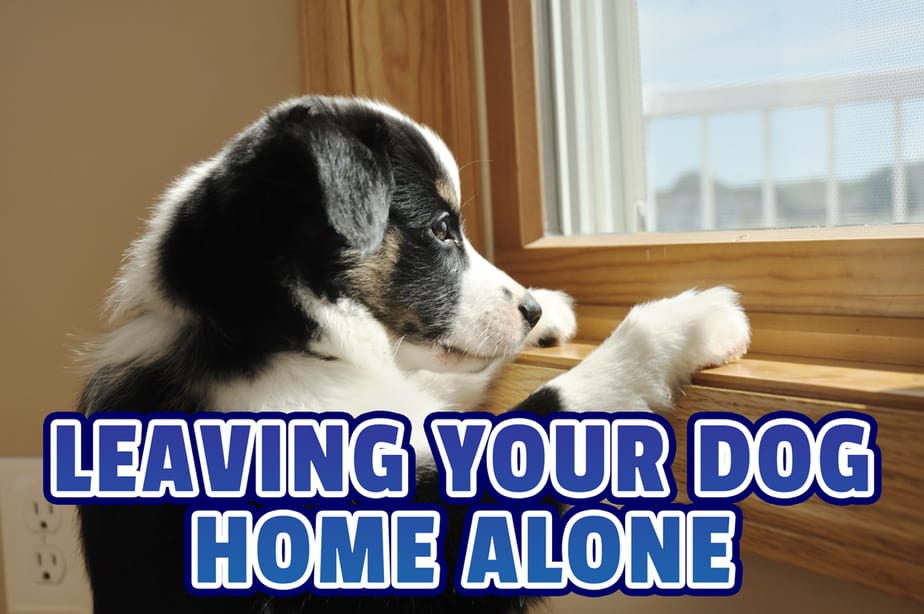While it might be your dream to be a stay-at-home dog parent, it’s not the reality for most of us. Instead, we have to work, not only to support ourselves but our dogs, too!
Knowing how long you can leave your dog home alone, as well as the best way to leave them so they are safe and comfortable will make being a dog owner much easier.
We’ll dig into the best ways to leave your dog home alone, how long you can leave your dog home alone, and options for when you have to leave your dog longer than recommended.
How long can I leave my dog alone?
The recommended length of time that your dog can stay home alone depends on their age, their tolerance to being alone, and their needs, such as toileting and food.
It will also depend on how well you have set them up for success. Do they have adequate dog toys available to them, such as teething and chew toys, and food dispensing toys?
Have they been trained to be OK with alone time? Do they have an adequate water supply, and a safe area, such as a pen.
One of the biggest factors is the ability of your dog to hold their bladder. The recommended hours are equal to your puppy’s age in months, plus one, as shown in the chart below.
| Age of Dog (Months) | How Long Can be Left Alone (Hours) |
|---|---|
| 2 | 3 |
| 3 | 4 |
| 6 | 7 |
| 12+ | 8+ |
Or in this infographic:
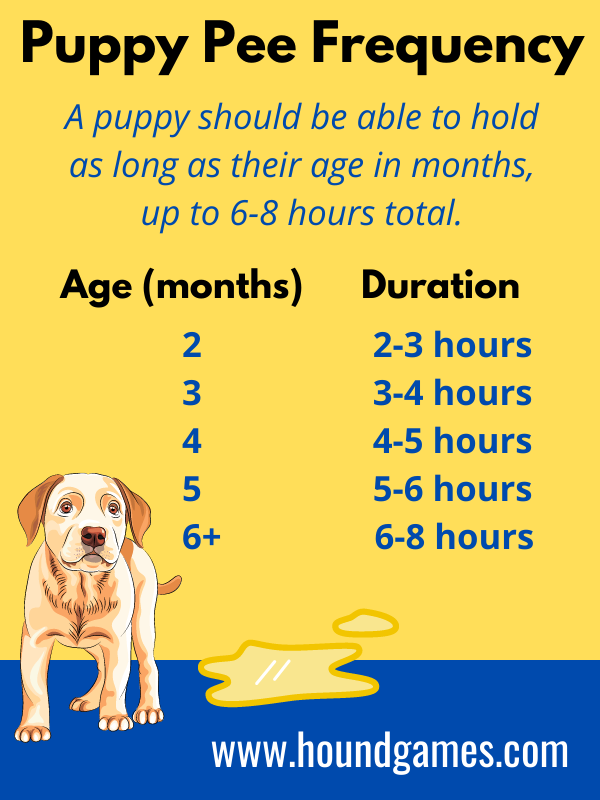
Can I leave my dog for 8-hours?
Yes, as long as you have a good setup for your dog, there is no problem with leaving a puppy alone for 8 hours. It’s important, however, to ensure they have a playpen set up with water, toys, and a place to go to the toilet.
If they are a puppy, ideally you will want to return in your lunch break for a potty break, exercise, and a cuddle!
You could also arrange for a dog walker, family member, or alternate pet service to visit, allowing your puppy the chance to use the bathroom during the day.
You’ll also notice that the above chart ends at 8+ hours, even when a puppy is 12-months-old.
Following the adage that you can leave your puppy alone for the number of months old they are plus one, why doesn’t the chart end at 13 hours?
Well, it’s unrealistic to expect a dog of any age to hold their bladder past 8-hours. The chart ends in 8+ to account for the exceptions where an owner may be away for 9-hours or so, because of work, and those dogs that do handle it fine.
However, in general, you won’t want to plan to leave your dog alone for longer than 8-hours. Not only is it a bladder issue, but dogs have physical and emotional needs that must be addressed to ensure a happy dog.
Providing fun toys is an absolute must when leaving your dog home alone. Ideally, you should change the toys often to provide a new experience.
We made the best puzzle toy for dogs ever made… well, of course I’d say that! But see for yourself, I’m sure you’ll agree.
We also have this article on setting up the best pen for your dog at home.
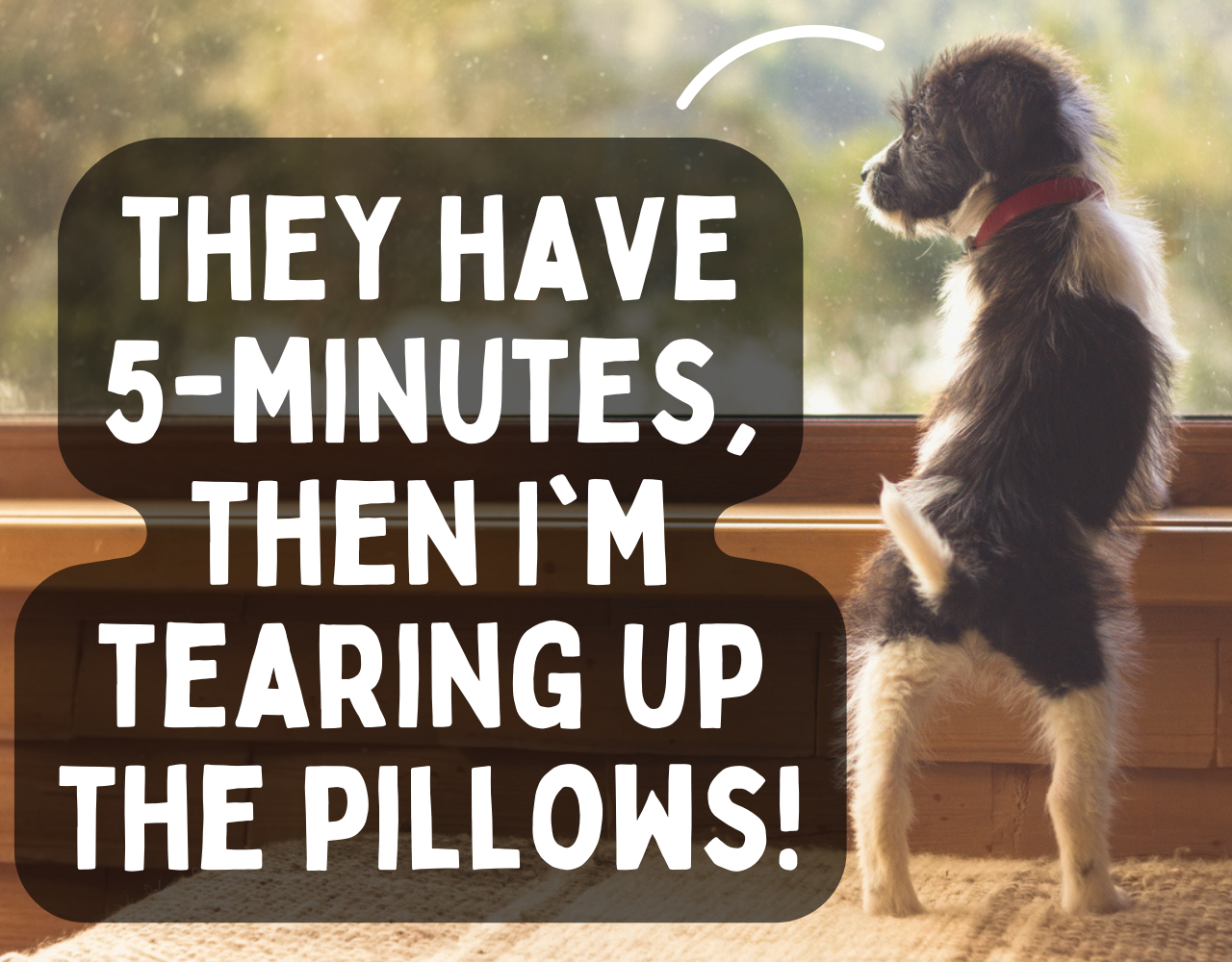
You can imagine that there are days when you certainly couldn’t make it through your 9-5 job without an opportunity to use the bathroom.
Even if your job is exceptionally busy, it’s often the case that you need to make a stop at the bathroom after clocking out at the end of the day.
It’s unfair to our dogs to ask them to hold their bladder for longer than 8-hours, and it can lead to a urinary tract infection or house training problems.
It’s also unfair to expect our dogs to be couch ornaments and be content with being left alone longer than 8-hours of a day, or 8 hours a day everyday.
While dogs usually sleep away a good portion of the middle of the day, being gone for longer than 8-hours means there isn’t ample opportunity for you to provide your dog with the exercise and enrichment they need when they are awake.
It’s not cruel to leave your dog home alone for an 8-hour workday, and you’ll be among many thousands of other dog owners who do the same.
You might want to read our post, Can you leave a puppy with a Kong or a Nylabone?
What is important, though, is that you make an effort to give your dog the attention and exercise they need when you are home. Here is a puppy exercise guide.
If you feel your puppy or adult dog isn’t getting enough interaction or they are lonely or anxious, then a doggie daycare might be a good idea.
Are you interested in reading our post How long after getting a puppy can you go on holiday?
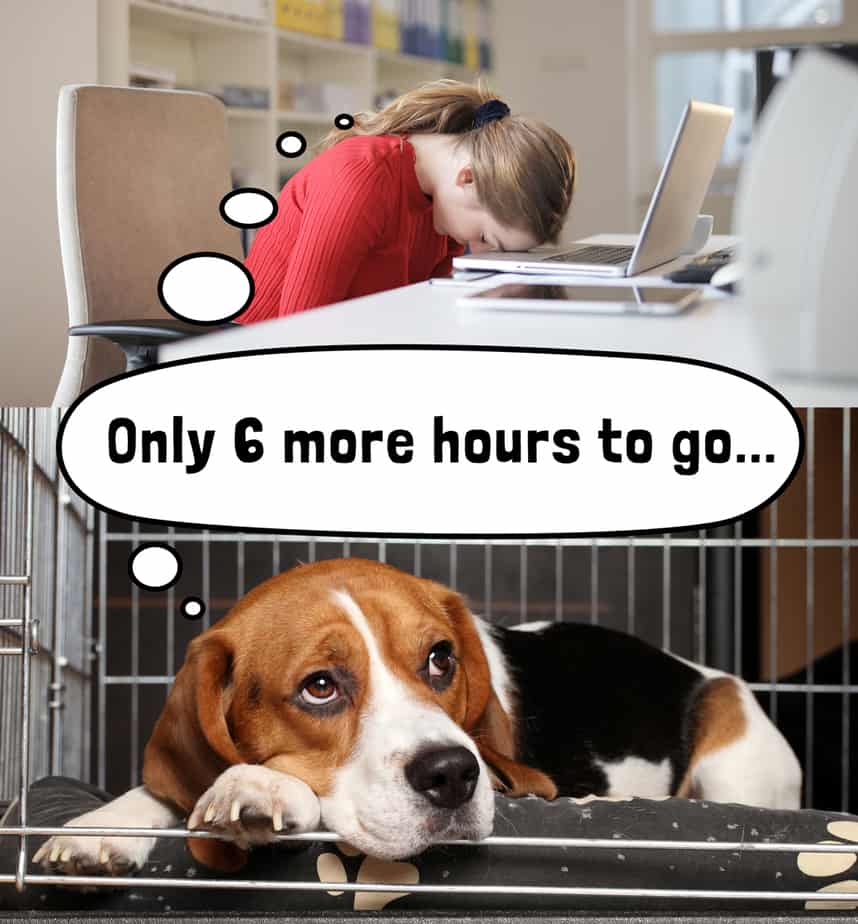
Tolerance to being left alone
Some dogs are better at being left alone than others. This can depend upon their breed. For instance, a Beagle is far more independent than say a Bichon Frise.
However, it can also depend on their individual temperament and whether they suffer from any separation anxiety. If your pup is left alone before being properly trained to be independent, you risk them having separation anxiety.
Knowing your dog’s ability to be independent you can determine yourself through knowing your dog and how they respond to you leaving them.
You can greatly improve the success of your dog being left alone through training practices that help them to be more independent.
Ensuring that you’re spending quality time with them when you are home is also important, including giving them adequate exercise and play time.
One of the best ways to teach your dog to be comfortable away from your side is through the use of “Place” training.
We highly recommend this practice and rate it as one of the best training tools in a dog owner’s arsenal.
Why? Well for a few reasons, but in the case of teaching your dog to be alone, it primes them for more independence, and if your dog suffers from separation anxiety to any degree, it’s a great tool to help remedy this.
We’ve covered “Place” training extensively here with the best methods of training.
Getting your puppy or adult dog to spend longer periods of time away from your side or in another room teaches them independence and builds confidence.
Can I leave my dog home alone for 12-hours?
It’s not recommended that you leave your dog home alone for 12-hours, except in exceptional circumstances. The average dog will not be able to comfortably hold their bladder for this long, and will also need much more stimulation than being left home alone provides.
There are a few circumstances that may require you to leave your dog alone for an extended time.
It’s important to note that this is not recommended if another option, such as a dog sitter, pet service, or boarding facility, is available.
Being left home alone for longer than 12-hours requires that your dog has access to a place to use the bathroom.
This may mean a dog door leading to a yard, or a litter box or potty pads that are placed inside the home.
Both of these options have their drawbacks, though.
Dogs being unsupervised in the back yard are at a risk to be stolen, escaping the yard, or otherwise finding harm.
Litter box or potty pad training your dog can be useful for situations like this, but if your overall goal is for your dog to use the bathroom outside, it can sometimes throw a wrench in that plan.
Dogs also do not automatically use potty pads and need to be trained to do so in advance.
If you are going to be leaving your dog for 12 hours a day alone regularly, then we recommend you find someone who can visit throughout the day. If this isn’t possible, then you may need to rethink having a dog and look into re homing them to a more suitable environment.
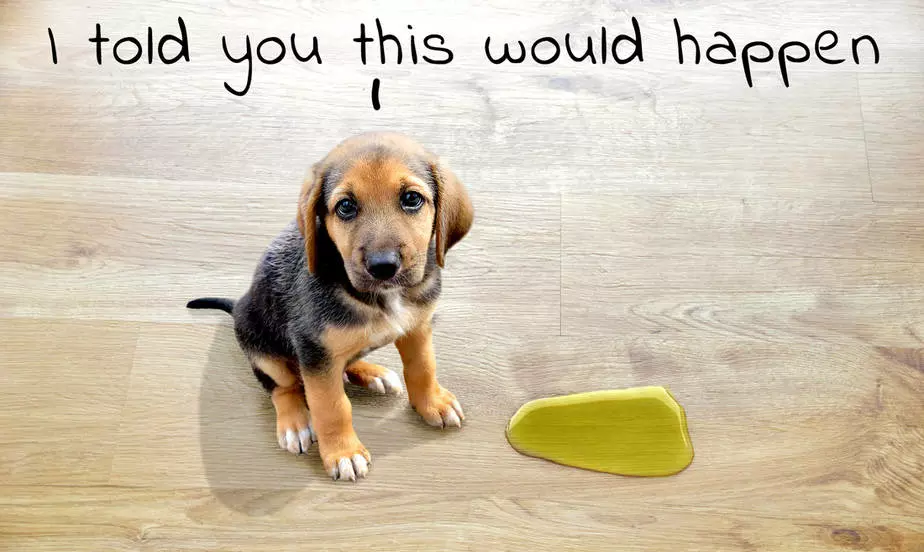
Besides a place for potty breaks your dog also needs ample water available. It’s OK for a dog to go 12-hours without eating, but your dog should not be left without water.
It’s best to leave water in multiple containers if you will be gone for a long period of time so that if one spills, your dog still has access to water.
Be sure to read our post on how much water they need, How Much Water Should Your Dog Drink: (With Chart!)
You can set your dog up in an exercise pen or in a designated room in your home that has been made safe for dogs, along with the water and access to a bathroom location. Including lots of fun toys!
All efforts should be made to find a dog walker, pet sitter, dog daycare, or other option for your dog to have a more regular schedule for their day.
However, in the case that you have an emergency come up on short notice, and need to be gone for 12-hours instead of 8, you can set your dog up for a longer day at home.
It’s important that this is a one-time event and that your dog receives adequate attention and exercise as soon as possible.
Being left alone for 12-hours a day regularly will likely cause boredom, which leads to destructiveness and even behavior disorders that require intervention.
When you leave your dog alone, you should consider their mental health as well as their physical ability to be alone.
Dogs are social creatures, and being alone for 10-12 hours or more on a regular basis is not healthy for them.
If it is required, then it’s a good idea to give them a morning walk before you leave your dog home alone. A long walk will let them sniff the world and stimulate their brain.
A lack of physical activity, plus being left home alone, could lead to problem behaviors. Social interaction is vital for a dog’s happiness.
Can I leave my dog home alone for 24-hours?
No, there is not a responsible way to leave a dog alone for an entire 24-hours without any attention from human contact. Not only is it extremely mentally taxing on dogs, which are social animals, but you also risk health problems.
Even if there’s an emergency, you will need to find a place to board your dog, or someone to come into your home to care for them if you cannot take your dog with you.
It’s also not legal in some places for your dog to be left alone for 24-hours. Most states have regulations requiring how often a dog should receive water, and access to a place to use the bathroom.
Regardless of the legalities, though, it is certainly not ethical to leave your dog alone for 24-hours.
Dog walkers, pet sitters, doggy daycare, boarding facilities, veterinary clinics, and even family and friends can be consulted to find someone willing to take care of your dog.
While these options come with an increased cost, it’s part of being a responsible dog owner.
It’s also a good plan to have these services lined up in advance. You will need to know the following factors:
- What vaccinations will your dog need if they are boarding?
- Which facility has the standard of care you prefer?
- Does your dog panic about new people, and need to have already met the dog sitter?
Having these questions answered in advance, when you don’t need to leave your dog alone, will ensure that you have options when an emergency arises and you can’t bring your dog.
Rather than stressing about the quality of care your dog will receive, you can instead be comfortable and have a plan for your dog to be well-cared for by someone else.
Is it cruel to leave a dog alone overnight?
Leaving a dog alone overnight can potentially be cruel, depending on the dog’s age, health, and temperament. For example, puppies, elderly dogs, or those with health issues may require more frequent attention, making overnight solitude distressing.
Also, dogs prone to separation anxiety or those unaccustomed to being alone could suffer stress, which can lead to destructive behaviors. It’s crucial to ensure the dog’s environment is safe and comfortable and to consider alternatives like pet sitters or boarding services for dogs who don’t cope well alone.
Separation Anxiety
Leaving your dog home alone for extended periods comes with the risk of causing separation anxiety in your dog.
Most of the tips in this next heading will help a dog suffering from separation anxiety, however, if your dog or puppy shows any of the following signs when you leave them alone, then be sure to read our post on separation anxiety here.
- Whining
- Crying
- Indoor defecating and urinating
- Destructive chewing
- Licking
- Digging
- Excessive panting
- Hiding
- Trembling
Separation anxiety is a real concern for dog owners leaving their dogs home alone. As pet parents, it’s up to us to ensure our dogs feel safe and loved.
How to leave your dog home alone
Before you jump straight into leaving your puppy or adult dog for extended periods of time, it’s important to set them up for success.
If you go immediately to extended time away from your pup, they could easily get separation anxiety.
If you’ve noticed your puppy is looking sad or depressed with you leaving them, be sure to read our post, Puppy is Sad and Depressed: What to do about it.
You can purchase this setup from Chewy here.
Here are some more tips to getting your pup ready for extended time away from you.
1. Get them used to time apart
When you are with your puppy, and especially through potty training, it’s important to be around your puppy at all times. Watching for their signs of needing to go to the toilet is crucial to success.
But if you are to be spending time during the days away from your dog, then you should also teach them it’s ok to be without you.
Leave your puppy in a room for a short time, and return with a treat. Try just a couple of minutes to begin with, then gradually increase this time period.
It’s best to do this exercise after they have gone to the toilet outside, so there’s less chance they’ll have an accident.
Adult dogs may be better at this, but if you have a pup, then you will need to teach them independence before extended periods of time alone.
Short periods of time apart will set them up for success. Ideally, you want them to be so comfortable without you there, they’ll just fall asleep.
2. Crate or pen
You should strongly consider getting a playpen for your puppy if you are regularly going to be leaving them alone for extended periods of time. Crate train your dog early on.
Leaving your puppy free reign of the house is a recipe for disaster, as they can get into anything and everything. A playpen will minimize the risk of your puppy getting hurt or into something they shouldn’t.
It can also give them an added sense of security.
If they are showing signs of anxiety, then having them in the crate can help give them an added sense of security. Be sure to make this a place of safety and enjoyment beforehand though.
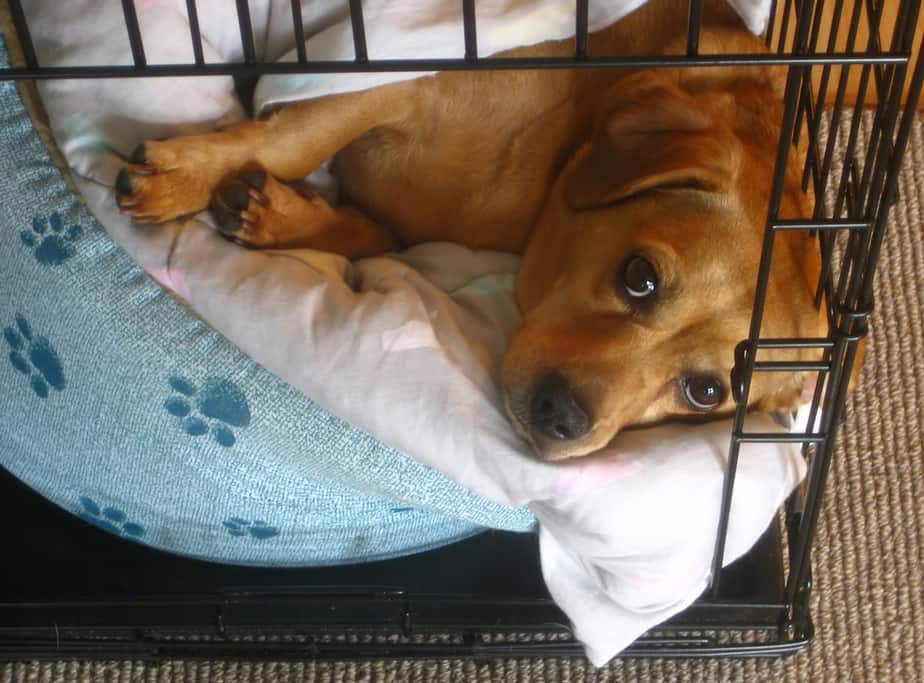
3. Leave something of yours
Leave them with an old slipper, or shirt with your smell on it. This can give them a sense of closeness even when you’re not home.
4. Provide adequate toys
This is self-explanatory. Keep your dog occupied with enrichment toys, puzzle toys, and favorite toys to make their time away from you more enjoyable.
Most dogs have a favorite toy so be sure to find it before you leave.
A quality food-dispensing toy is a great idea to keep them busy and not hungry! We recommend our Hide’n’Treat puzzle toys which you can find in our Shop, or read our blog post, The 20 Best Dog Enrichment Toys.
5. Exercise beforehand
Before you leave, spend time with them burning off energy. Go into the yard for a runaround. Be sure to also spend at least a few minutes on training, as this will tire out their mind as well.
A morning walk is a good idea. If you can, a mid-day visit and a play would do wonders for their mood as you keep your dog active.
6. Leave on the radio
Leaving on some quiet noise in the house can help reduce unwanted barking from masking outside noises. It can also reduce noises that induce a fear response, such as a loud unexpected noise from somewhere outside.
7. Provide plenty of fresh water
Set up two bowls of fresh water, in case one gets spilled. They can go without food for extended periods, but not water.
8. Leave without the fanfare
Don’t make a big deal about your departure. If you carry on, you’ll leave your puppy or dog in a state of excitement. Give them a cuddle a few minutes before leaving, and then quietly leave your home.
9. Setup a good environment
Be sure to check the temperature isn’t too hot or cold, and leave a light source on for them. The more comfortable they are, the quicker the time will pass for them.
10. Dog walker, dog sitter, and professional dog trainers
Pet services are a great way to lessen the blow of time away from your pup. There’s no substitute for human interaction for your dog.
There are many different pet services available. If you don’t enjoy walking your dog, getting a dog walker to come while you’re at work is a great idea.
If you want to get your furry friend trained up, then a professional dog trainer is a great idea, and getting them to do this while you’re away is ideal.
11. Routine
A good routine will ensure your pet knows what to expect. This can be difficult for shift works, but people who work 9-5 should keep to a schedule.
A good routine might look like this:
- A set alarm clock time
- Breakfast
- A quick walk
- Off to work without fanfare.
- A quick visit home at lunch, or a pet service visit.
12. Company
Dogs are social animals, so if you’re thinking of getting a puppy, you might want to consider getting two! Having other dogs around can lessen the blow of alone time and give them a much-needed friend.
Older dogs may even enjoy the company of a new dog!
Final Word
As a pet parent, it’s up to us to be responsible when leaving our dogs home alone. However, it’s not too difficult to do this with the right setup, routine, and training.
If you’re just running errands, it’s no big deal, but extended time away can create stress for your pooch.
In general, 8 hours a day away from a confident, independent dog is fine. Anything longer and you will need to consider ways to reduce the impact this can cause.
Hopefully, this has given you a good understanding of how long you can leave your dog home alone, as well as the best way to set them up for success.

